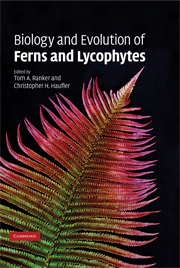Book contents
- Frontmatter
- Contents
- List of contributors
- Preface
- Acknowledgments
- Part I Development and morphogenesis
- Part II Genetics and reproduction
- Part III Ecology
- 8 Phenology and habitat specificity of tropical ferns
- 9 Gametophyte ecology
- 10 Conservation biology
- 11 Ex situ conservation of ferns and lycophytes – approaches and techniques
- Part IV Systematics and evolutionary biology
- Index
- References
9 - Gametophyte ecology
Published online by Cambridge University Press: 11 August 2009
- Frontmatter
- Contents
- List of contributors
- Preface
- Acknowledgments
- Part I Development and morphogenesis
- Part II Genetics and reproduction
- Part III Ecology
- 8 Phenology and habitat specificity of tropical ferns
- 9 Gametophyte ecology
- 10 Conservation biology
- 11 Ex situ conservation of ferns and lycophytes – approaches and techniques
- Part IV Systematics and evolutionary biology
- Index
- References
Summary
Introduction
Seed plant ecologists would find incredulous a proposal to study the ecology of a species that did not include critical examination of all aspects of recruitment in the field, relying instead on laboratory studies of seed germination, seedling growth and mortality, etc. Yet students of fern and lycophyte ecology are limited to data on gametophyte growth and reproduction collected almost exclusively from laboratory studies. They are expected to assume that these studies accurately reflect growth and reproduction in nature. Field investigations of gametophyte biology are minimal on such critical topics as: the role of morphological and physiological diversity among gametophyte taxa in habitat selection; the time frame and method of gametophyte development, maturation, sexual differentiation, and sporophyte production; the breeding systems and habitats effectively contributing new recruits to sporophyte populations; or the number and frequency of recruits. In addition to producing a decidedly unbalanced view of fern and lycophyte ecology, the absence of ecological data on the gametophytic phase of fern biology has left science with important misconceptions regarding this critical phase of the life cycle. The gametophyte not only provides the opportunity for sexual reproduction (and thus controls genetic diversity) but also determines (along with vegetative reproduction) recruitment, species habitat selection, species migration, and, ultimately, fern and lycophyte evolution.
Reasons for the dearth of field studies on gametophyte ecology are both perceived and real. It is much more difficult to find and to identify gametophyte plants than to do the same with sporophytes.
- Type
- Chapter
- Information
- Biology and Evolution of Ferns and Lycophytes , pp. 222 - 256Publisher: Cambridge University PressPrint publication year: 2008
References
- 53
- Cited by



